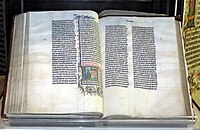
Back Dooie See-rolle Afrikaans مخطوطات البحر الميت Arabic مخطوطات البحر الميت ARZ Manuscritos del Mar Muertu AST Kumran əlyazmaları Azerbaijani Ҡумран ҡулъяҙмалары Bashkir Рукапісы Мёртвага мора Byelorussian Скруткі Мёртвага мора BE-X-OLD Кумрански ръкописи Bulgarian মৃত সাগরের পাণ্ডুলিপি Bengali/Bangla
| Livro Sagrado |
| Bíblia |
|---|
 |
|
Desenvolvimento |
Os Manuscritos do Mar Morto (ou Rolos do Mar Morto) são uma coleção de centenas de textos e fragmentos de texto encontrados em cavernas de Qumran, no Mar Morto, no fim da década de 1940 e durante a década de 1950.[1] Foram compilados por uma doutrina de judeus conhecida como essênios, que viveram em Qumran do século II a.C., até aproximadamente 70.[1] Porções de toda a Bíblia Hebraica foram encontradas, exceto do Livro de Ester e do Livro de Neemias.[1] Os manuscritos incluem também livros apócrifos e livros de regras da própria seita.[1] A datação mais correta e amplamente aceita entre arqueólogos e historiadores, é entre o século II a.C. e meados do século I d.C. As datações atribuídas através do método histórico-crítico batem perfeitamente com as datações em radiocarbono.[2] Muito se especulou sobre uma suposta datação de 2000 a.C., sendo assim, o mais antigo compilado de textos bíblicos já encontrado, isso se deve por conta de matérias tendenciosas como o famoso The weirdo cult that saved the Bible,[1] mas tal matéria não é considerada um estudo acadêmico e carece de fontes confiáveis. Outro fato que atesta a data de meados do século II a.C., é o tipo de cerâmica em que os fragmentos foram encontrados, datando de 135 a.C. a 104 a.C.[3]
Atualmente, estão guardados no Santuário do Livro do Museu de Israel, em Jerusalém.[1] Quanto àqueles fragmentos que estão num museu estadunidense, foram dados como falsos.[4][5]
- ↑ a b c d e f «The Weirdo Cult That Saved the Bible» (em inglês). Slate. 17 de janeiro de 2008. Consultado em 19 de julho de 2011.
[...] I didn't know exactly what the Dead Sea Scrolls were. [...] But since I have come to Israel to get as close as I can to the Bible, I make a visit to the scrolls at the Shrine of the Book. [...] Housed at the Israel Museum in Jerusalem, the shrine consists of [...]. [...] The scrolls, as I have now learned, are a collection of hundreds of texts and fragments of text found in caves at Qumran, on the Dead Sea, during the late 1940s and '50s. (Famously, the first were discovered when Bedouin shepherds chanced on one of the caves.) The scrolls were compiled by an apocalyptic Jewish sect known as the Essenes (or Yahad), which lived in Qumran from the second century B.C. until around A.D. 70. Portions of every Hebrew Bible book except Esther and Nehemiah were found—the glory is a complete copy of the Book of Isaiah. The scrolls also include apocrypha and the sect's own rule books. The Dead Sea Scrolls are by far the earliest versions of biblical text, dating a full 1,000 years earlier than the original Hebrew Bible text used by Jews today. (In other words, the biblical writings in the Dead Sea Scrolls are twice as old as the next oldest Hebrew Bible text. There are Greek translations of the Bible that date from the fourth century A.D., several hundred years after the scrolls.)
- ↑ Vieira, Fernando Mattiolli (2008). «Os manuscritos do Mar Morto e a gênese do Cristianismo» (PDF). Universidade Estadual Paulista. Dissertação de mestrado em história: 99. Cópia arquivada em 8 de outubro de 2023
- ↑ Wise, Michael (setembro de 1986). «Literary Sources for the History of Palestine and Syria: The Dead Sea Scrolls: Part 1. Archaeology and Biblical Manuscripts». The Biblical Archaeologist (em inglês) (3): 140–154. ISSN 0006-0895. doi:10.2307/3209995. Consultado em 10 de maio de 2024
- ↑ «Fragmentos dos Manuscritos do Mar Morto em museu dos EUA são falsos». ZAP. 17 de março de 2020. Consultado em 12 de fevereiro de 2021
- ↑ Marques, Ana Cristina. «Como falsificadores conseguiram enganar um museu com falsos manuscritos do Mar Morto». Observador. Consultado em 10 de maio de 2024